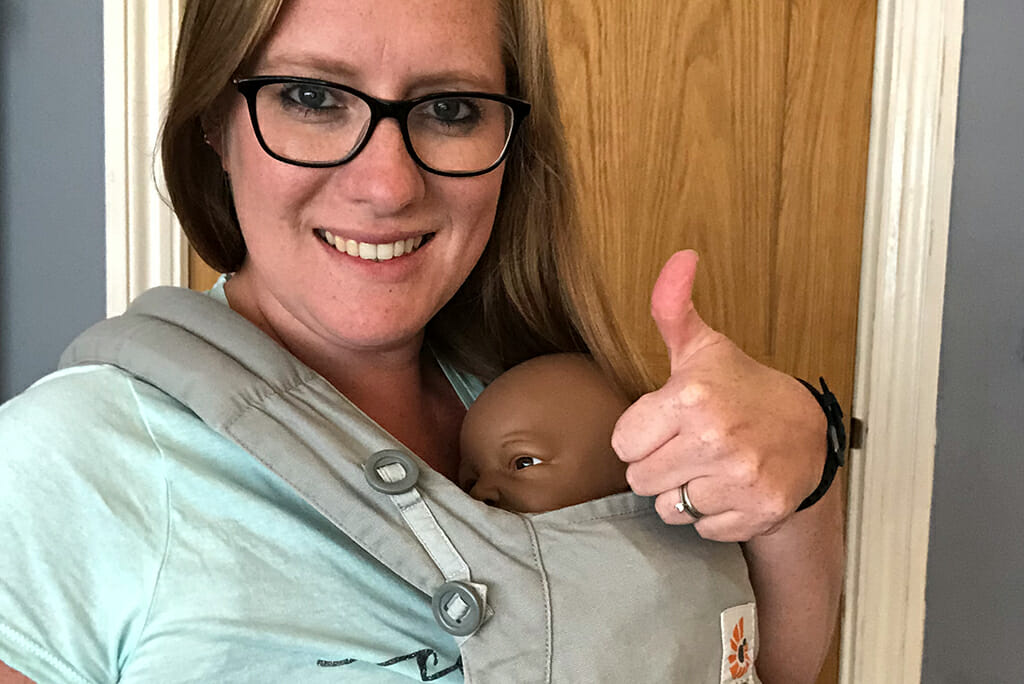
Picking the right baby carrier for your newborn and using it correctly
Lizzie Start – Carrying consultant, educator & trainer at Cake Club Sling Library & Parenting Support in Southend & Born to Carry
For new parents, faced with carrying their tiny bundle of joy in those early days of sleeplessness, adrenaline and bliss, the idea of choosing a sling can be utterly overwhelming. There are so many different options, so many choices to make, seemingly endless styles to choose between – stretchy wrap, buckle carrier, soft or structured, parent-facing, world-facing, back carry, hip carry… Where do you even begin?!
For newborns, safety is key. The most important thing to consider is how to keep your baby’s airway clear, which comes down to how they are positioned and supported in the sling. The safest position for your newborn is to be upright, rather than reclined or cradled. Their size, birthweight, length and muscle tone may need to be taken into consideration when choosing an appropriate sling or carrier.
Wraps
Stretchy wraps, like the Ergobaby Aura Baby Wrap, are suitable for all newborns, and when used correctly are safe, secure and super snuggly. They fit all body types, as there are no buckles to adjust or fixed panels or straps, and can be worn by pretty much anyone. With support from a carrying consultant or educator, stretchy wraps can even be used by low birthweight, poorly or premature babies, and can be a really effective tool in the practice of kangaroo care.
MY TOP TIP: When tying your stretchy wrap, make sure that you work out any slack as you tighten and keep the fabric fairly tight to your body, allowing just a little bit of room for your newborn. As you tighten the fabric around your baby, ensure that their airway remains clear and that no fabric covers the front of their face at any time. Their body should be snug to you, with their little legs supported from knee to knee.
Hybrids
If a wrap isn’t for you, but you’d still like something that’s designed with your newborn in mind and supports their snuggly little body, then a soft buckle carrier like the Ergobaby Embrace is an increasingly popular option. The waistband is soft and can be worn high up on the waist so as not to put too much pressure on the postnatal body, and the fabric is soft enough to mould around your baby’s body, respecting the natural curve of the newborn spine but offering them enough support to keep them safe. The top of the carrier is open, allowing for a nice, clear airway for your new babe.
MY TOP TIP: When fitting your newborn into the carrier, squish the fabric between their legs and smooth the panel up their back, taking care not to overextend their hips. Once you have secured the straps, gently tilt your baby’s pelvis so that their knees are higher up than their bottom and they have a slight curve to the spine.
Baby Carrier
If you’re after something that will last, and you’re willing to invest, then consider a structured birth-to-toddler carrier such as the Ergobaby Adapt or Omni 360 as both of these carriers are suitable from newborn as long as baby weighs 7lbs and is at least 20 inches in height. As with all carriers, it is imperative that the fit is correct. The panel of the carrier should finish at baby’s ear-height so they can maintain an open airway, wearing the waistband nice and high up your torso will help position them at the correct height on your body, and folding the neck support cushion inside the panel of the carrier will provide them with extra head and neck support for the first 6 weeks or so.
MY TOP TIP: Whatever carrying option you choose for your new baby, always follow the TICKS safety guidelines, read the instructions carefully or watch a video (ideally one made by a carrying consultant!) and if in doubt, contact your local sling library or babywearing educator for additional support.



